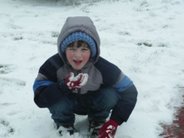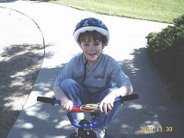Autism is a complex developmental disability that typically appears during the first three years of life. The result of a neurological disorder that affects the functioning of the brain, autism impacts the normal development of the brain in the areas of social interaction and communication skills. Children and adults with autism typically have difficulties in verbal and non-verbal communication, social interactions, and leisure or play activities.
Autism is one of five disorders coming under the umbrella of Pervasive Developmental Disorders (PDD), a category of neurological disorders characterized by "severe and pervasive impairment in several areas of development," including social interaction and communications skills (DSM-IV-TR). The five disorders under PDD are Autistic Disorder, Asperger's Disorder, Childhood Disintegrative Disorder (CDD), Rett's Disorder, and PDD-Not Otherwise Specified (PDD-NOS). Each of these disorders has specific diagnostic criteria as outlined by the American Psychiatric Association (APA) in its Diagnostic & Statistical Manual of Mental Disorders (DSM-IV-TR).
Autism is a spectrum disorder. The symptoms and characteristics of autism can present themselves in a wide variety of combinations, from mild to severe. Although autism is defined by a certain set of behaviors, children and adults can exhibit any combination of the behaviors in any degree of severity. Two children, both with the same diagnosis, can act very differently from one another and have varying skills.
Parents may hear different terms used to describe children within this spectrum, such as autistic-like, autistic tendencies, autism spectrum, high-functioning or low-functioning autism, more-abled or less-abled. More important than the term used is to understand that, whatever the diagnosis, children with autism can learn and function productively and show gains with appropriate education and treatment.
Every person with autism is an individual, and like all individuals, has a unique personality and combination of characteristics. Some individuals mildly affected may exhibit only slight delays in language and greater challenges with social interactions. The person may have difficulty initiating and/or maintaining a conversation. Communication is often described as talking at others (for example, monologue on a favorite subject that continues despite attempts by others to interject comments).
People with autism process and respond to information in unique ways. In some cases, aggressive and/or self-injurious behavior may be present. Persons with autism may also exhibit some of the following traits:
Insistence on sameness; resistance to change
Difficulty in expressing needs; uses gestures or pointing instead of words
Repeating words or phrases in place of normal, responsive language
Laughing, crying, showing distress for reasons not apparent to others
Prefers to be alone; aloof manner
Tantrums
Difficulty in mixing with others
May not want to cuddle or be cuddled
Little or no eye contact
Unresponsive to normal teaching methods
Sustained odd play
Spins objects
Inappropriate attachments to objects
Apparent over-sensitivity or under-sensitivity to pain
No real fears of danger
Noticeable physical over-activity or extreme under-activity
Uneven gross/fine motor skills
Not responsive to verbal cues; acts as if deaf although hearing tests in normal range.
For most of us, the integration of our senses helps us to understand what we are experiencing. For example, our senses of touch, smell and taste work together in the experience of eating a ripe peach: the feel of the peach fuzz as we pick it up, its sweet smell as we bring it to our mouth, and the juices running down our face as we take a bite. For children with autism, sensory integration problems are common. Their senses may be over-or under-active. The fuzz on the peach may actually be experienced as painful; the smell may make the child gag. Some children with autism are particularly sensitive to sound, finding even the most ordinary daily noises painful. Many professionals feel that some of the typical autism behaviors are actually a result of sensory integration difficulties.
There are many myths and misconceptions about autism. Contrary to popular belief, many autistic children do make eye contact; it just may be less or different from a non-autistic child. Many children with autism can develop good functional language and others can develop some type of communication skills, such as sign language or use of pictures. Children do not "outgrow" autism but symptoms may lessen as the child develops and receives treatment.
One of the most devastating myths about autistic children is that they cannot show affection. While sensory stimulation is processed differently in some children with autism, they can and do give affection. But it may require patience on a parent's part to accept and give love in the child's terms.
There is no known single cause for autism, but it is generally accepted that it is caused by abnormalities in brain structure or function. Brain scans show differences in the shape and structure of the brain in autistic versus non-autistic children. Researchers are investigating a number of theories, including the link between heredity, genetics and medical problems. In many families, there appears to be a pattern of autism or related disabilities, further supporting a genetic basis to the disorder.
While no one gene has been identified as causing autism, researchers are searching for irregular segments of genetic code that autistic children may have inherited. It also appears that some children are born with a susceptibility to autism, but researchers have not yet identified a single "trigger" that causes autism to develop.
Other researchers are investigating the possibility that under certain conditions, a cluster of unstable genes may interfere with brain development resulting in autism. Still other researchers are investigating problems during pregnancy or delivery as well as environmental factors such as viral infections, metabolic imbalances, and exposure to environmental chemicals.
Autism tends to occur more frequently than expected among individuals who have certain medical conditions, including Fragile X syndrome, tuberous sclerosis, congenital rubella syndrome, and untreated phenylketonuria (PKU). Some harmful substances ingested during pregnancy also have been associated with an increased risk of autism. Early in 2002, The Agency for Toxic Substances and Disease Registry (ATSDR) prepared a literature review of hazardous chemical exposures and autism and found no compelling evidence for an association; however, there was very limited research and more needs to be done.
The question of a relationship between vaccines and autism continues to be debated. In a 2001 investigation by the Institute of Medicine, a committee concluded that the "evidence favors rejection of a causal relationship.... between MMR vaccines and autistic spectrum disorders (ASD)." The committee acknowledged, however, that "they could not rule out" the possibility that the MMR vaccine could contribute to ASD in a small number of children. While other researchers agree the data does not support a link between the MMR and autism, more research is clearly needed.
Whatever the cause, it is clear that children with autism and PDD are born with the disorder or born with the potential to develop it. It is not caused by bad parenting. Autism is not a mental illness. Children with autism are not unruly kids who choose not to behave. Furthermore, no known psychological factors in the development of the child have been shown to cause autism.
There are no medical tests for diagnosing autism. An accurate diagnosis must be based on observation of the individual's communication, behavior, and developmental levels. However, because many of the behaviors associated with autism are shared by other disorders, various medical tests may be ordered to rule out or identify other possible causes of the symptoms being exhibited.
A brief observation in a single setting cannot present a true picture of an individual's abilities and behaviors. Parental (and other caregivers') input and developmental history are very important components of making an accurate diagnosis. At first glance, some persons with autism may appear to have mental retardation, a behavior disorder, problems with hearing, or even odd and eccentric behavior. To complicate matters further, these conditions can co-occur with autism. However, it is important to distinguish autism from other conditions, since an accurate diagnosis and early identification can provide the basis for building an appropriate and effective educational and treatment program.
As part of a well-baby/well-child visit, your child's doctor should do a "developmental screening" asking specific questions about your baby's progress. The National Institute of Child Health and Human Development (NICHD) lists these five behaviors that signal further evaluation is warranted:
Does not babble or coo by 12 months
Does not gesture (point, wave, grasp) by 12 months
Does not say single words by 16 months
Does not say two-word phrases on his or her own by 24 months
Has any loss of any language or social skill at any age.
Having any of these five "red flags" does not mean your child has autism, but because the characteristics of the disorder vary so much, a child should have further evaluations by a multidisciplinary team that may include a neurologist, psychologist, developmental pediatrician, speech/language therapist, learning consultant, or other professionals knowledgeable about autism.
While there is no one behavioral or communications test that can detect autism, several screening instruments have been developed that are now used in diagnosing autism.
CARS rating system (Childhood Autism Rating Scale), developed by Eric Schopler in the early 1970s, is based on observed behavior. Using a 15-point scale, professionals evaluate a child's relationship to people, body use, adaptation to change, listening response, and verbal communication.
The Checklist for Autism in Toddlers (CHAT) is used to screen for autism at 18 months of age. It was developed by Simon Baron-Cohen in the early 1990s to see if autism could be detected in children as young as 18 months. The screening tool uses a short questionnaire with two sections, one prepared by the parents, the other by the child's family doctor or pediatrician.
The Autism Screening Questionnaire is a 40 item screening scale that has been used with children four and older to help evaluate communication skills and social functioning.
The Screening Test for Autism in Two-Year Olds, being developed by Wendy Stone at Vanderbilt, uses direct observations to study behavioral features in children under two. She has identified three skills areas - play, motor imitation, and joint attention - that seem to indicate autism.
Whether you or your child's pediatrician is the first to suspect autism, your child will need to be referred to someone who specializes in diagnosing autism spectrum disorders. This may be a developmental pediatrician, a psychiatrist or psychologist. Other professionals may be included who are better able to observe and test your child in specific areas.
This multidisciplinary assessment team may include some or all of the following professionals. They may also be involved in treatment programs.
Developmental pediatrician - Treats health problems of children with developmental delays or handicaps.
Child psychiatrist - A medical doctor who may be involved in the initial diagnosis; can prescribe medication and provide help in behavior, emotional adjustment and social relationships
Clinical psychologist - Specializes in understanding the nature and impact of developmental disabilities including autism spectrum disorders. May perform psychological and assessment tests and may help with behavior modification and social skills training.
Occupational therapist - Focuses on practical, self-help skills that will aid in daily living such as dressing, eating; may work on sensory integration, coordination of movement, and fine motor skills.
Physical therapist - Helps to improve the use of bones, muscles, joints, and nerves to develop muscle strength, coordination and motor skills.
Speech/language therapist - Involved in the improvement of communication skills including speech and language.
Social Worker - May provide counseling services or act as case manager helping to arrange services.
It is important that parents and professionals work together for the child's benefit. While professionals will use their experience and training to make recommendations about your child's treatment options, you have unique knowledge about his/her needs and abilities.
Once a treatment program is in place, communication between parents and professionals is essential to monitor the child's progress. Here are some guidelines for working with professionals:
Be informed. Learn as much as you can about your child's disability so you can be an active participant in determining care. If you don't understand terms used by professionals, ask for clarification.
Be prepared. Be prepared for meetings with doctors, therapists, and school personnel. Write down your questions and concerns, and then note the answers.
Be organized. Many parents find it useful to keep a notebook detailing their child's diagnosis and treatment as well as meetings with professionals.
Communicate. It's important to ensure open communication - both good and bad. If you don't agree with a professional's recommendation, for example, say specifically why you don't.
Getting Past the Diagnosis
Often, the time immediately after the diagnosis is a difficult one for families, filled with confusion, anger and despair. These are normal feelings. But there is life after a diagnosis of autism. Life can be rewarding for a child with autism and all the people who have the privilege of knowing the child. While it isn't always easy, you can learn to help your child find the world an interesting and loving place.
(ALL taken from the Autistic Society of America's website at: www.autism-society.org
Subscribe to:
Post Comments (Atom)


























 This website is part of the autism-assembly, this is a coalition of
members of the autistic community who share the common goal of seeking
acceptance for those on the autistic spectrum, who aim to educate about
autism, and who are not seeking a cure for autism. This is part of the
global autism rights movement.
This website is part of the autism-assembly, this is a coalition of
members of the autistic community who share the common goal of seeking
acceptance for those on the autistic spectrum, who aim to educate about
autism, and who are not seeking a cure for autism. This is part of the
global autism rights movement.



No comments:
Post a Comment